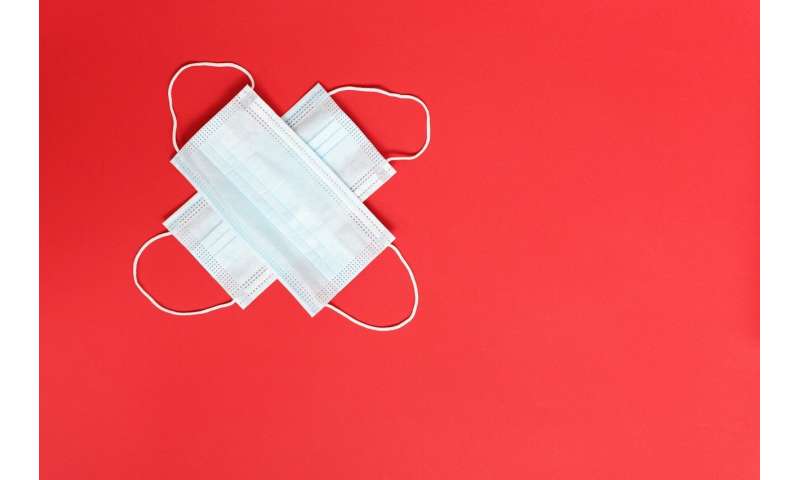
A team of researchers have tested everything from t-shirts and socks to jeans and vacuum bags to determine what type of mask material is most effective at trapping the ultrafine particles which may contain viruses such as SARS-CoV-2, the virus which causes COVID-19.
The researchers, from the University of Cambridge and Northwestern University, tested the effectiveness of different fabrics at filtering particles between 0.02 and 0.1 micrometres—about the size of most viruses—at high speeds, comparable to coughing or heavy breathing. They also tested N95 and surgical masks, which are more commonly used in healthcare settings.
Previous studies have only looked at a small selection of fabrics when the wearer is breathing normally, when particles are expelled at lower speed. Studying more fabrics and testing them at higher speeds provides a more robust evidence base for the effectiveness of fabric masks.
The results, reported in the journal BMJ Open, show that most of the fabrics commonly used for non-clinical face masks are effective at filtering ultrafine particles. N95 masks were highly effective, although a reusable HEPA vacuum bag actually exceeded the N95 performance in some respects.
As for homemade masks, those made of multiple layers of fabric were more effective, and those which also incorporated interfacing, which is normally used to stiffen collars, showed a significant improvement in performance. However, this improvement in performance also made them more difficult to breathe through than an N95 mask.
The researchers also studied the performance of different fabrics when damp, and after they had gone through a normal washing and drying cycle. They found that the fabrics worked well while damp and worked sufficiently after one laundry cycle, however previous studies have shown that repeated washing degrades the fabrics, and the researchers caution that masks should not be reused indefinitely.
“Fabric masks have become a new necessity for many of us since the start of the COVID-19 pandemic,” said first author Eugenia O’Kelly from Cambridge’s Department of Engineering. “In the early stages of the pandemic, when N95 masks were in extremely short supply, many sewers and makers started making their own fabric masks, meeting the demands that couldn’t be met by supply chains, or to provide a more affordable option.”
While there are numerous online resources which help people make their own masks, there is little scientific evidence on what the most suitable materials are.
“There was an initial panic around PPE and other types of face masks, and how effective they were,” said O’Kelly. “As an engineer, I wanted to learn more about them, how well different materials worked under different conditions, and what made for the most effective fit.”
For the current study, O’Kelly and her colleagues built an apparatus consisting of sections of tubing, with a fabric sample in the middle. Aerosolised particles were generated at one end of the apparatus, and their levels were measured before and after they passed through the fabric sample at a speed similar to coughing.
The researchers also tested how well each fabric performed in terms of breathing resistance, based on qualitative feedback from users. “A mask which blocks particles really well but restricts your breathing isn’t an effective mask,” said O’Kelly. “Denim, for example, was quite effective at blocking particles, but it’s difficult to breathe through, so it’s probably not a good idea to make a mask out of an old pair of jeans. N95 masks are much easier to breathe through than any fabric combinations with similar levels of filtration.”
In preparation for the study, the researchers consulted with online sewing communities to find out what types of fabric they were using to make masks. Due to the severe shortage of N95 masks at the time, several of the sewers reported that they were experimenting with inserting vacuum bags with HEPA filters into masks.
The researchers found that single-use and reusable vacuum bags were effective at blocking particles, but caution that the single-use bags should not be used in face masks, as they fall apart when cut, and may contain component materials which are unsafe to inhale.
“It’s a matter of finding the right balance—we want the materials to be effective at filtering particles, but we also need to know they don’t put users at risk of inhaling fibres or lint, which can be harmful,” said O’Kelly.
The researchers caution that their study has several limitations: namely, that they did not look at the role which fit plays in filtering particles. In a related project, O’Kelly has been studying how the fit of masks in healthcare settings can be improved. In addition, many viruses are carried on droplets which are larger than those looked at in the current study.
Source: Read Full Article
